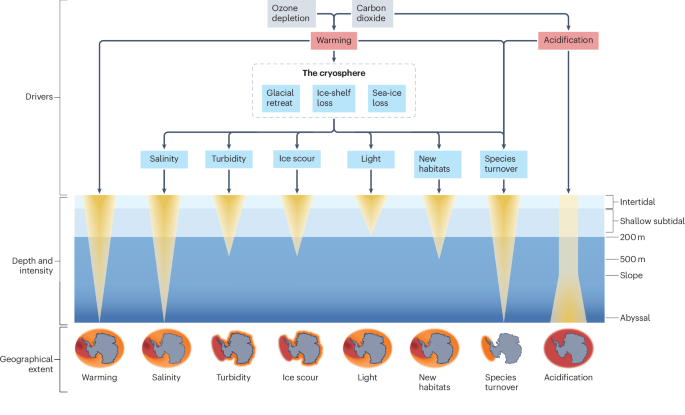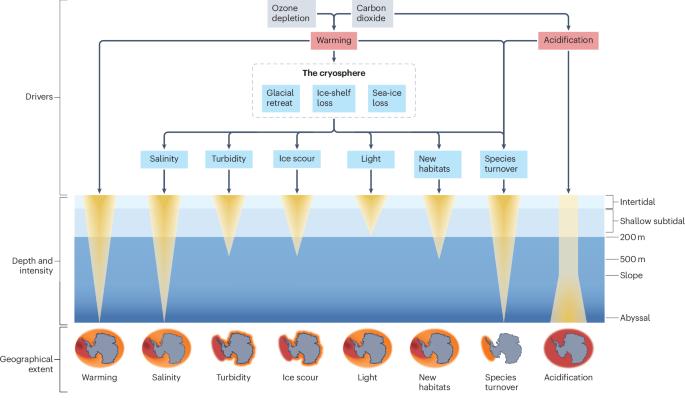Antarctic benthic ecological change
引用次数: 0
Abstract
The benthic community around Antarctica is diverse and highly endemic. These cold-adapted species are under threat from local and global drivers, including warming, acidification and changes to the cryosphere. In this Review, we summarize observed, experimental and modelled Antarctic benthic ecological change. Warming, glacial melt and retreat, and reduced ice cover are causing regional benthic biomass to increase or decrease, depending on the additional influences of ice scour, turbidity and freshening. Additionally, the dominance of previously cold-restricted or light-restricted taxa is increasing, and several ecological tipping points have already been breached, leading to ecological phase shifts in some habitats. The largest changes have been observed in communities in the shallows of the West Antarctic Peninsula, notably change to distribution, biodiversity, biomass and trophic structure. Models based on observational and experimental evidence indicate that these changes will spread deeper and eastwards throughout this century. Available data are primarily limited to a handful of shallow-water taxa; thus, future work will need to involve multispecies observations and experiments encompassing multiple drivers to understand community and ecosystem responses, and autonomous monitoring techniques to fill geographical, bathymetric, seasonal and taxonomic gaps; advances in environmental DNA and artificial-intelligence-based techniques will help to rapidly analyse such data. The cold-adapted communities on the seafloor around Antarctica are vulnerable to environmental changes. This Review summarizes the regional variations in present and future benthic ecological changes driven by the impacts of climate change and acidification.


南极底栖生态变化
南极洲周围的底栖生物群落种类繁多,且极具地方特色。这些适应寒冷的物种正受到当地和全球驱动因素的威胁,包括气候变暖、酸化和冰冻圈的变化。在这篇综述中,我们总结了观测、实验和模拟的南极底栖生物生态变化。气候变暖、冰川融化和后退以及冰盖减少正在导致区域底栖生物量的增加或减少,这取决于冰层冲刷、浑浊和清新的额外影响。此外,以前受冷限制或受光限制的类群的优势地位正在增加,一些生态临界点已经被突破,导致一些栖息地的生态阶段性转变。在南极半岛西部浅滩的群落中观察到了最大的变化,特别是分布、生物多样性、生物量和营养结构的变化。根据观测和实验证据建立的模型显示,这些变化将在本世纪向更深处和东部蔓延。现有数据主要局限于少数浅水类群;因此,未来的工作需要进行多物种观测和实验,包括多种驱动因素,以了解群落和生态系统的反应,并采用自主监测技术来填补地理、水深、季节和分类学方面的空白;环境 DNA 和基于人工智能的技术的进步将有助于快速分析这些数据。南极洲周围海底的冷适应群落很容易受到环境变化的影响。本综述总结了气候变化和酸化影响导致的目前和未来海底生态变化的区域差异。
本文章由计算机程序翻译,如有差异,请以英文原文为准。
求助全文
约1分钟内获得全文
求助全文

 求助内容:
求助内容: 应助结果提醒方式:
应助结果提醒方式:


